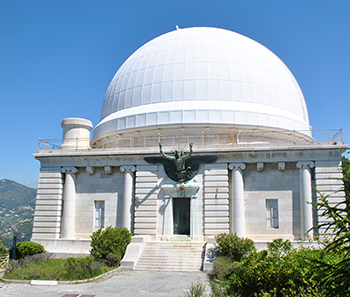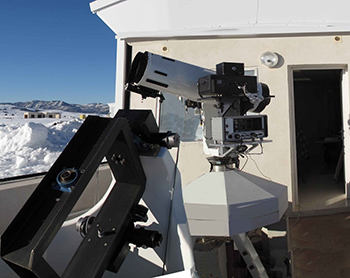The Côte d’Azur Observatory (Observatoire de la Côte d’Azur or OCA) has a remarkable architectural and scientific heritage, which is open to the public. But far from looking to the past, OCA remains an internationally recognized center for research in Earth Sciences and Astronomy. Today, the buildings designed by Charles Garnier consort with precision mechanics, high performance computing centers and virtual observatories.
 With some 450 staff located on four sites (Mont Gros and Valrose in Nice, Sophia Antipolis, and the Plateau de Calern observatory), OCA is one of 25 French astronomical observatories responsible for the continuous and systematic collection of observational data on the Earth and the Universe. Its role is to explore, understand and transfer knowledge about Earth sciences and astronomy, whether in astrophysics, geosciences, or related sciences such as mechanics, signal processing, or optics.
With some 450 staff located on four sites (Mont Gros and Valrose in Nice, Sophia Antipolis, and the Plateau de Calern observatory), OCA is one of 25 French astronomical observatories responsible for the continuous and systematic collection of observational data on the Earth and the Universe. Its role is to explore, understand and transfer knowledge about Earth sciences and astronomy, whether in astrophysics, geosciences, or related sciences such as mechanics, signal processing, or optics.
To produce and use data collected by large ground-based and space-based instruments, OCA takes a comprehensive approach that combines theory, modeling, observation, analysis and creation of data banks. Through its joint services unit, Galilée, OCA provides its research laboratories with operational support (administrative and financial management, technical services, IT, etc.) and a wide range of research facilities to implement its scientific policy (shared high performance computing center, virtual observatory, shared mechanical design lab and mechanics workshop, clean rooms, observatories on the Plateau de Calern, in California, Antarctica and South America).
OCA strives to ensure that the contemporary science issues and developments that it produces are passed on for societal benefit. Firstly, the OCA laboratories actively contribute to teaching at Nice Sophia Antipolis University (UNS), from Bachelor’s to doctorate level. In addition, OCA is setting up a unique scheme for observational astrophysics and geosciences dedicated to university teaching and research – the Planet Universe Teaching Center (Centre Pédagogique Planète Univers or C2PU) – which will give students the opportunity to learn through experimental research in the areas specific to OCA. Secondly, OCA is heavily committed to its mission of disseminating knowledge as broadly as possible, taking advantage of the unique combination of its exceptional heritage and contemporary research.
OCA, an independent institution
The Côte d’Azur Observatory is an astronomical observatory and public administrative institution directed by Stéphane MAZEVET. Enjoying administrative and financial independence, OCA spearheads the region’s research activities in earth sciences and astronomy, carried out in three research units under shared supervision (UNS, CNRS, IRD, OCA): Artemis, Geoazur and Lagrange.
About the Plateau de Calern observation site
In the 1970s, 1980s and 1990s, the Plateau de Calern housed instruments that were forerunners in their field, including laser rang finding (photo) and interferometry. The Schmidt telescope for imaging wide fields of view with limited aberrations was also intensely utilized until the early 2000s. Today, the scientific life of the Plateau continues with projects that make the most of experience gained and the special relationship between astronomy and geophysics, including laser range finding, time transfer, and space geodesy.
 Earth sciences and astronomy rely heavily on observations which aim to monitor, understand and model the natural objects and phenomena with which these fields are concerned. Due to the truly essential nature of observation for research in the Earth sciences and astronomy, the Côte d’Azur Observatory is seeking to have its Calern site acknowledged as an “accredited observation site” by the CNRS National Institute of Earth Sciences and Astronomy (INSU).
Earth sciences and astronomy rely heavily on observations which aim to monitor, understand and model the natural objects and phenomena with which these fields are concerned. Due to the truly essential nature of observation for research in the Earth sciences and astronomy, the Côte d’Azur Observatory is seeking to have its Calern site acknowledged as an “accredited observation site” by the CNRS National Institute of Earth Sciences and Astronomy (INSU).
OCA wishes to stress the importance of observational techniques developed in the past on the Plateau de Calern, particularly interferometry, and to share the observation techniques that are being developed today and which legitimate recognition of the Calern site as an INSU-CNRS-accredited observation site.
Contact :
Observatoire de la Côte d’Azur, Boulevard de l’Observatoire - CS 34229 F 06304 Nice Cedex 4 - Ph. 04 92 00 30 11


